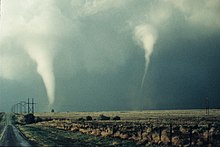44:
necessary to determine whether or not damage was created by a family or a single tornado. Oftentimes, tornadoes are small and don’t make it far before dying out. However, large tornadoes are also present in many situations that track for very long distances. To determine the average track length of a tornado, both of these factors must be taken into account. The track length of a tornado can be as short as a few feet to over 100 miles, thus making the average track length for a typical tornado about 1–2 miles. In some cases, such as the
20:
55:
of March 1925 was one such event. It could either have been the longest single tornado recorded or a family of tornadoes. A thorough re-analyses project found that it was probably one continuous tornado for most of its path, likely bounded by separate tornadoes at the beginning and end of the very
43:
thunderstorm. These families form a line of successive or parallel tornado paths and can cover a short span or a vast distance. Tornado families are sometimes mistaken as a single continuous tornado, especially prior to the 1970s. Sometimes the tornado tracks can overlap and expert analysis is
56:
long track (VLT) tornado, and likely another significant tornado spawned many miles later. However, many other exceptional VLT events were later found to be tornado families with much shorter tornado path segments than originally thought, notably the
279:
US Department of
Commerce, NOAA. “Tornadoes FAQ.” National Weather Service, NOAA’s National Weather Service, 13 June 2015, www.weather.gov/lmk/tornadoesfaq#:~:text=Path%20lengths%20can%20range%20from,tornadoes%20occasionally%20can%20be%20violent.
87:", a term that originally referred to what now is typically a tornado family. Successive tornadoes may be considered by some as separate tornadoes (and thus constituting a tornado family) only when spawned by a new
83:. Especially when newly forming, tornadoes may sometimes exhibit brief breaks in the damage path even as the parent circulation is continuous. Such events may be considered as "
79:
may also cause damage paths to appear continuous, although this was more an issue for historic tornadoes as such damage usually is now distinguishable as caused by
61:
57:
48:
of March 1990, different tornadoes of a tornado family merge, making discerning whether an event was continuous or not more difficult.
45:
222:
197:
178:
153:
299:
72:
209:
165:
8:
241:
213:
169:
193:
80:
118:
68:
52:
137:
294:
253:
240:; D. W. Burgess; C. A. Doswell III; M. S. Gilmore; J. A. Hart; S. F. Piltz (2013).
217:
173:
108:
84:
237:
198:"Some Noteworthy Aspects of the Hesston, Kansas, Tornado Family of 13 March 1990"
236:
51:
Some tornado damage remains a mystery even today due to a lack of evidence. The
113:
88:
288:
192:
258:
24:
92:
96:
76:
40:
19:
242:"The 1925 Tri-State Tornado Damage Path and Associated Storm System"
36:
138:
A Comprehensive
Glossary of Weather Terms for Storm Spotters
16:
Succession of tornadoes originating from the same storm cell
223:
10.1175/1520-0477(1994)075<1007:SNAOTH>2.0.CO;2
179:
10.1175/1520-0493(1988)116<0495:OSIOUS>2.0.CO;2
23:
Twin tornadoes spawned from the same supercell in the
196:; C. A. Doswell; D. W. Burgess; J. F. Weaver (1994).
154:"On Some Issues of United States Tornado Climatology"
151:
286:
152:Doswell, Charles A. III; D. W. Burgess (1988).
62:Charleston–Mattoon, Illinois tornado family
257:
221:
177:
147:
145:
18:
75:, or some combination thereof. Intense
287:
246:e-Journal of Severe Storms Meteorology
142:
67:Tornado families can be a result of
13:
14:
311:
58:Woodward, Oklahoma tornado family
46:Hesston-Goessel, Kansas tornadoes
273:
230:
186:
131:
1:
124:
7:
102:
10:
316:
202:Bull. Amer. Meteor. Soc
95:(and from within a new
259:10.55599/ejssm.v8i2.47
60:of April 1947 and the
28:
73:cyclic tornadogenesis
22:
39:spawned by the same
214:1994BAMS...75.1007D
194:Davies, Jonathan M.
170:1988MWRv..116..495D
81:straight-line winds
69:satellite tornadoes
27:on April 29th, 2010
29:
119:Tornado intensity
53:Tri-State Tornado
307:
280:
277:
264:
263:
261:
238:Johns, Robert H.
234:
228:
227:
225:
190:
184:
183:
181:
149:
140:
135:
109:Tornado outbreak
315:
314:
310:
309:
308:
306:
305:
304:
285:
284:
283:
278:
274:
268:
267:
235:
231:
191:
187:
150:
143:
136:
132:
127:
105:
35:is a series of
17:
12:
11:
5:
313:
303:
302:
300:Tornadogenesis
297:
282:
281:
271:
266:
265:
229:
208:(6): 1007–17.
185:
164:(2): 495–501.
141:
129:
128:
126:
123:
122:
121:
116:
114:Tornadogenesis
111:
104:
101:
89:tornadocyclone
33:tornado family
15:
9:
6:
4:
3:
2:
312:
301:
298:
296:
293:
292:
290:
276:
272:
270:
260:
255:
251:
247:
243:
239:
233:
224:
219:
215:
211:
207:
203:
199:
195:
189:
180:
175:
171:
167:
163:
159:
158:Mon. Wea. Rev
155:
148:
146:
139:
134:
130:
120:
117:
115:
112:
110:
107:
106:
100:
98:
94:
91:or low-level
90:
86:
82:
78:
74:
70:
65:
64:of May 1917.
63:
59:
54:
49:
47:
42:
38:
34:
26:
21:
275:
269:
249:
245:
232:
205:
201:
188:
161:
157:
133:
66:
50:
32:
30:
25:Great Plains
252:(2): 1–33.
93:mesocyclone
289:Categories
125:References
97:wall cloud
77:downbursts
41:supercell
37:tornadoes
103:See also
85:skipping
295:Tornado
210:Bibcode
166:Bibcode
254:doi
218:doi
174:doi
162:116
99:).
291::
248:.
244:.
216:.
206:75
204:.
200:.
172:.
160:.
156:.
144:^
71:,
31:A
262:.
256::
250:8
226:.
220::
212::
182:.
176::
168::
Text is available under the Creative Commons Attribution-ShareAlike License. Additional terms may apply.
